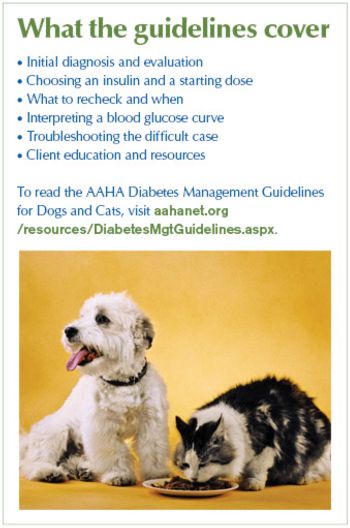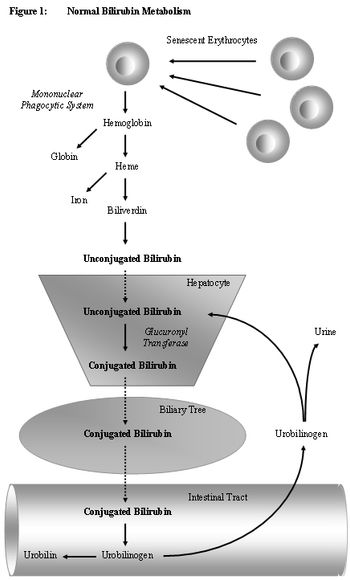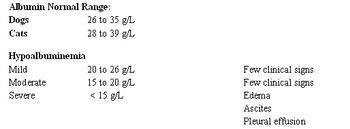
Even with the advances in diabetic care, diabetes in pets has remained a particular point of interest and discussion among veterinary professionals.

Even with the advances in diabetic care, diabetes in pets has remained a particular point of interest and discussion among veterinary professionals.

Answers to your questions about diabetes mellitus.

A tip for treating this endocrine disease in cats.

Dr. David Bruyette answers this reader question.

It is unlikely the low-dose prednisone treatment is resulting in the panting the owner is reporting.

Dr. Audrey Cook explains how the new guidelines were created.

A diagnostic tip for this common endocrine disease.

This study's goal was to determine and compare the likelihood of remission in cats with newly diagnosed diabetes mellitus when treated with glargine insulin, protamine zinc insulin (PZI), or Lente insulin.

What steps would you take to help this dog?

To teach owners of newly diagnosed diabetic pets how to inject insulin, I have them practice with sterile water.

In our April issue as an accompaniment to the article "Identifying the reasons behind difficult-to-control diabetes in dogs" by Dr. Audrey Cook, we asked you if you had questions for Dr. Cook about diabetes. Here is a second installment of her responses.

Trilostane, currently the most used treatment for PDH, is a synthetic steroid analogue. It competitively inhibits the 3-beta hydroxysteroid dehydrogenase enzyme blocking cortisol, aldosterone and sex hormone production.

Jaundice (or icterus), broadly defined, refers to the accumulation of excessive amounts of bilirubin in either the circulation or the tissues.

Naturally occurring hyperadrenocorticism (HAC) is an endocrine disorder resulting from the excess production of cortisol or other adrenal hormones by the adrenal cortex. The clinical syndrome was first documented in people by Dr. Harvey Cushing in 1932 and is also known as Cushing's syndrome.

In 2005 Eli Lily announced the discontinuation of the majority of animal derived source insulins in addition to the lente and ultralente lines of product. This changed the landscape of veterinary diabetic management. Ultimately, the best insulin for your patient may be the one you are most familiar with; however, general guidelines will help choose the insulin that will give you the best success with your patients.

There are several manifestations of adrenal disease in cats, ranging from hypoadrenocorticsm to several forms of hyperadrenal activity. All are considered relatively rare, but it is possible that we may discover some more frequently if we have a higher index of suspicion.

Canine hypothyroidism is one of the more common endocrine diseases seen by small animal clinicians. As thyroid screening has become more frequently utilized, practitioners have become more aware of the frequency with which hypothyroidism occurs.

Normal neural stimulation of the hypothalamus produces corticotropin-releasing hormone (CRH). Corticotropin-releasing hormone stimulates the release of adrenocorticotropic hormone (ACTH) from the anterior pituitary. ACTH exerts its effects on the adrenal cortex and stimulates the zona fasiculata to release cortisol, the zona reticularis to release androgens and the zona glomerulosa to release mineralocorticoids, but the primary effect of ACTH is on cortisol release.

There have been several new findings in canine and feline endocrinology. We will highlight those that are useful and applicable to clinical practice. New diagnostic protocols and treatments will be discussed where appropriate.

Insulinomas are tumors that arise from the beta cells of the pancreatic islets and secrete excessive amounts of insulin, resulting in hypo?glycemia. The secretion of insulin is usually episodic, as are the resulting clinical signs. Insulinomas in dogs are typically malignant and almost always metastasize; even those appearing benign on histo?pathological evaluation. Insulinomas are rare in dogs.

Possible mechanisms of hypercalcemia.

Albumin is the major determinant of oncotic or colloidal osmotic pressure, the force that holds fluids within the vascular compartment. Most of the important osmotically-active particles in the bloodstream (such as sodium, urea and glucose) are relatively small, and pass freely between the vascular and interstitial compartments, the body's two major extracellular fluid compartments.

Hyperthyroidism is the most common endocrine disorder in cats. This disorder has been noted with increased frequency since the late 1970's. It also appears to be more prevalent in certain geographic locations.

Hyperadrenocorticism can be pituitary-dependent (PDH), secondary to cortisol-secreting adrenocortical neoplasia, or iatrogenic. Spontaneous hyperadrenocorticism is primarily a disease of middle-aged to older dogs.

Diabetes mellitus can be a very frustrating disease to deal with. The typical diabetic animal referred to a specialist in internal medicine is invariably difficult to control, insulin resistant, prone to ketoacidosis and/or hypoglycemia, and usually has concurrent diseases that complicate therapy.